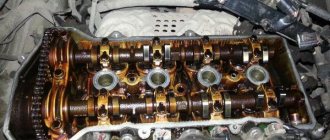Toyota engine with a volume of 4 liters and marking 1GR-FE produced since 2002. Scope of application: all-wheel drive and rear-wheel drive SUVs and pickups. The first version of the engine came out with phase regulator VVT-i on one of the camshafts, later it began to be installed Dual VVT-i system (on both shafts).
Below we will talk about the technical characteristics of the motor, the features of its design and the subtleties of maintenance.
Characteristics of the 1GR-FE engine
An internal combustion engine labeled 1GR-FE demonstrates the following technical characteristics:
- exact volume – 3956 cubic meters. cm ;
- power (hp) – from 236 to 285;
- torque (N/m) – from 361 to 387;
- compression ratio - 10 or 10.4;
- lubricant change frequency - every 10 thousand km (optimally every 5 thousand);
- permissible oil consumption - up to a liter per 1000 km;
- engine oil volume – 5.2 l ;
- environmental class – Euro-5;
- fuel used - AI-95;
- food – injector
- aluminum cylinder block, cast iron liners;
- number of cylinders – 6;
- valves per cylinder – 4;
- piston stroke – 95 mm;
- cylinder diameter – 94 mm;
- operating temperature – without exact data;
- Timing – chain;
- years of production – from 2002 to the present.
approximate resource - in practice more than 300 thousand km .
Fuel consumption
The Toyota 4.0 1GR-FE engine demonstrates the following fuel consumption data:
- Land Cruiser Prado J150 6 automatic transmission and all-wheel drive: city - 14.5 l, highway - 8.4 l, mixed version - 10.6 l .
- Land Cruiser Prado J120 with 5 automatic transmission and all-wheel drive: city mode - 16.7, on the highway - 9.8, average value - 12.4 .
- Gasoline consumption on an FJ Cruiser SUV with 5 automatic transmission and rear-wheel drive: in the city - 13.8, outside the city - 11.2.
Toyota FJ Cruiser
Why and when is it needed?
If there is no thermal gap, then at elevated temperatures, the valve will lengthen towards the camshaft, causing pressure on its elements. This in turn leads to compression of the springs and poor valve lapping. When the engine reaches operating temperature, it will no longer fulfill its main purpose: closing for complete sealing.
The second scenario is to increase the thermal gap. This happens when operational wear occurs on the cams, camshaft or drive elements. This has a negative impact on the valve mechanism and its resources. If the situation is not corrected, the valve will begin to close late and not completely, and the filling of the cylinder will deteriorate.
Technical features
The 4-liter engine in question replaced its predecessor 5VZ-FE in 2002 . Unlike the previous engine model, the Toyota 1GR-FE engine turned out to be more high-torque. The 6-cylinder petrol engine was equipped with a variable valve timing system VVT-I .
Engine Toyota 3.4 5VZ-FE
The aluminum cylinder block provided by the developers is sensitive to overheating. If the chain breaks, it bends the valve. The material for the manufacture of connecting rods was forged steel, cast iron sleeves.
Each cylinder has four valves, so there are 24 in total . DOHC type are responsible for gas distribution .
Aluminum cylinder block 1GR-FE
Under the hood of SUVs, the engine is located longitudinally . The architecture of the internal combustion engine can be considered square, since the piston stroke and cylinder diameter are almost the same (with a difference of 1 mm). Peak performance is observed at 5200 rpm , and maximum torque is available at 3700 rpm.
The first version of the motor differed from the subsequent ones:
- The phase distribution occurred at the inlet.
- There were no hydraulic compensators.
- There is no spacer in the shirt.
- The crankshaft had 9 counterweights.
- Large piston (skirt less reduced).
- The oil filter was located on the top of the oil cooler.
After 2009, the Dual-VVT-i system , camshaft beds and a spacer in the cooling jacket were provided. The filter (dismountable) along with the oil cooler were moved to the lower part of the engine, and an exhaust air supply system . Spark plugs have become more advanced, and the crankshaft design has been simplified.
Cylinder head 1GR-FE with two camshafts
When is tensioner replacement required?
The timing chain tensioner is an auxiliary component of the gas distribution mechanism. It provides the required degree of tension along the entire length and does not depend on external factors: temperature, load on the car and wear.
The chain drive is reliable and resistant to extreme driving conditions. The only thing the part is susceptible to is wear due to expansion under the influence of high temperature. Over time, it stretches out and is no longer able to function normally. Uncharacteristic noise and vibration appear, links jump off the sprockets, which leads to the destruction of individual engine mechanisms. The tensioner prevents such problems from occurring. Its functions:
- maintaining chain tension at the required level;
- damping of link vibrations.
This detail eliminates the need to manually calibrate chain tension. In addition, the tensioner is a unit that removes additional load from other parts, thus reducing wear. If this part malfunctions, serious problems are likely to arise that will require lengthy repairs and financial investments.
A broken tensioner can be seen even by a non-car mechanic. When the limit position of the rod on it is reached, this means that the spare part is not able to work correctly.
The 1GR tensioner on the Prado 120 needs to be replaced along with the chain itself.
1GR Service
The average service life of the 1GR-FE internal combustion engine is 300 thousand , but measured loads and compliance with maintenance regulations make it possible to squeeze out an additional 100 thousand km. is of fundamental importance . The Toyota concern recommends using original lubricant with a viscosity of 5w30 .
Original motor oil. Article 08880-10705
Proper maintenance of the Toyota 1GR-FE engine involves:
- Changing the oil and oil filter every 10 thousand km (preferably 5000)
- Renewing the air filter every 20 thousand .
- Change antifreeze when the mark reaches 50,000 .
- Check the timing chain at 100 thousand, then every 30.
- Renewing spark plugs every 30,000 km .
Timing belt of motor 1GR-FE
Valve adjustment is mandatory, since the Toyota 4.0 1GR-FE engine is not equipped with hydraulic compensators.
Adjusting valve clearance on Prado 120
If you independently adjust the valves on a Prado 120 4 liter, you need to carefully study the procedure and strictly follow them:
- It is necessary to remove: the cylinder head cover, inspection hole plugs, generator tire and spark plugs.
- Slowly turn the flywheel on the generator counterclockwise. This must be done until their control marks coincide.
- After alignment, the flywheel is turned a quarter turn clockwise, tightly clamping the spark plug hole with your hand. Next, it must be sharply turned counterclockwise to its original position.
- Having aligned the marks on the wheel and crankcase, you need to check the gaps between the adjusting screws. The normal gap is 0.6 to 0.8 mm. If necessary, the gaps are adjusted by turning the screws.
After completing the procedure, tighten the locknuts and check the clearances again. The operation is simple and can be done quickly enough if the car enthusiast understands the design of the car. Otherwise, the adjustment should be entrusted to professionals, because there is a high probability of not only not eliminating the problem, but also aggravating it.
Disadvantages and weaknesses of 1GR-FE
Weaknesses of the Toyota 1GR-FE engine:
- Gas distribution system (problems with sprockets, camshafts).
- Fuel pump resistor.
- VVT-i coupling.
VVT-i coupling - Pump (leaks appear).
water pump
The location of the Toyota 1GR-FE engine in the engine compartment affects the service life of the transmission due to high output, and also complicates access to components during inspection and repair (which can be considered a minus, for example, if it is not possible to hang the engine). Moderate driving and high-quality roads (despite the fact that the engine is installed specifically on SUVs) increase the resource.
A blown head gasket turns out to be the most serious defect of the power plant in question. Breakdown occurs more often in the rear cylinders, overheating and a change in the shape of the mating plane of the block head occurs.
Set (left and right) of cylinder head gaskets 1GR-FE
With increasing mileage, the risk of developing a similar problem increases. Irregularities in the operation of the cooling system accelerate and provoke breakdown. You need to pay attention to the expansion tank and radiator honeycombs . Leaks and clogged honeycombs should be eliminated as quickly as possible.
What is valve adjustment
The operation of gasoline engines is to supply the air-fuel mixture to the cylinder tanks. And then complete removal of the exhaust gases contained in them. Operations take place through valves that close and open openings.
There are two types: inlet and outlet. They open in turn to fill or empty the cylinders. The action is controlled by the camshaft, its specialized cams alternating the action of the valves to open or close the cylinder bores.
A special point of the mechanism is the thermal gap between the camshaft pusher and the valve mechanism.
The standard operating temperature level is high, and the metal tends to expand when heated. Such a process will inevitably lead to a change in the shape of the parts and it is necessary to correct the resulting gap. This work is called “valve adjustment.”
Tuning
Refinement is carried out using a compressor based on Eaton M90 with an intercooler . To install a power-increasing structure on a Toyota 1GR-FE engine, you will have to lower the compression ratio (options include a thick head gasket or CP Pistons with a compression ratio of 9.2 ).
Eaton M90
You will also need a new pump, injectors, intake and exhaust replacement. With this approach to tuning, you can achieve a performance of 320 horses . Installation of kits with greater efficiency is allowed, but a TRD compressor for a Toyota 4.0 1GR-FE engine is considered optimal .
Malfunctions and repairs
Problems encountered on engines:
- Breakdown of the rear part of the gasket located between the block and the head. It is found on engines with mileage of 150 thousand km or more. The likelihood of breakdown increases if the engine overheats. The damaged part must be replaced; if antifreeze and oil are mixed, fresh fluids must be added.
- If the cylinder mirrors are worn or damaged, the factory recommends installing a new block. It is possible to repair a damaged unit with the installation of non-original parts. There are companies that line and bore 1GR generation motors.
- Destruction of the spark plug housing due to increased tightening torque. The damaged part must be unscrewed and replaced with a new one; it is recommended to use a torque wrench when tightening.
- Oil leakage at the junction of the cover and the block. The repair consists of replacing the gasket and applying additional sealant to the connection line.
What cars was 1GR installed on?
Toyota 4Runner N210
The engine marked 1GR-FE was installed on the following Toyota cars:
- 4Runner (N210 and N280);
- Hilux (AN10 and AN120);
- Tundra (XK30 and XK50);
- Fortuner (AN50 and AN160);
- Land Cruiser Prado (J120 and J150);
- Land Cruiser J200;
- FJ Cruiser J15;
- Lexus GX 400 J150.
- Tacoma (N200).
Lexus GX 400 J150











